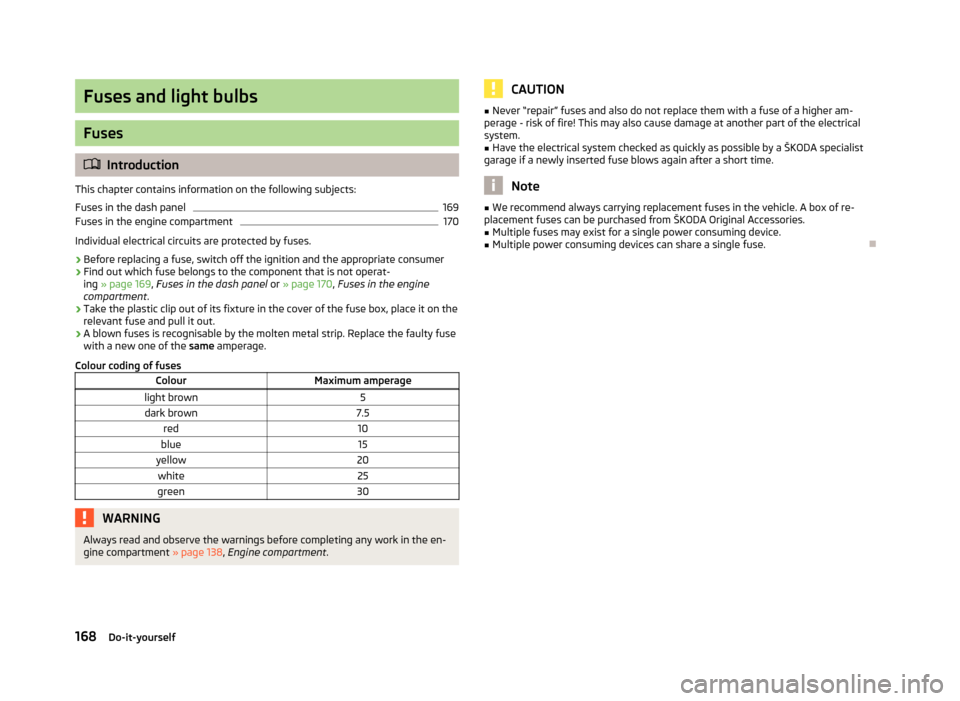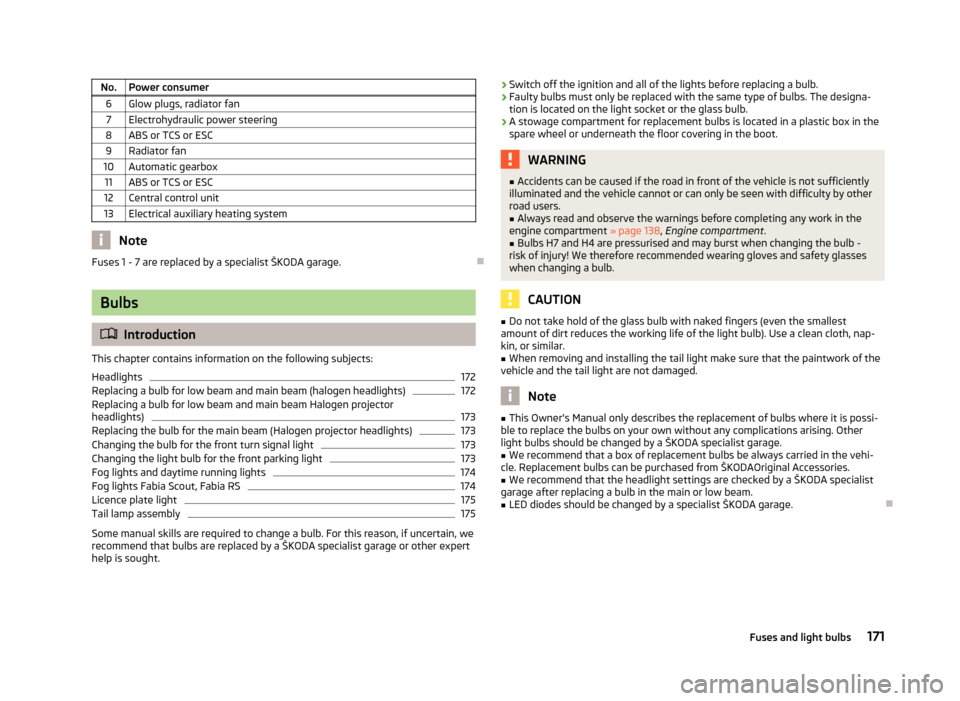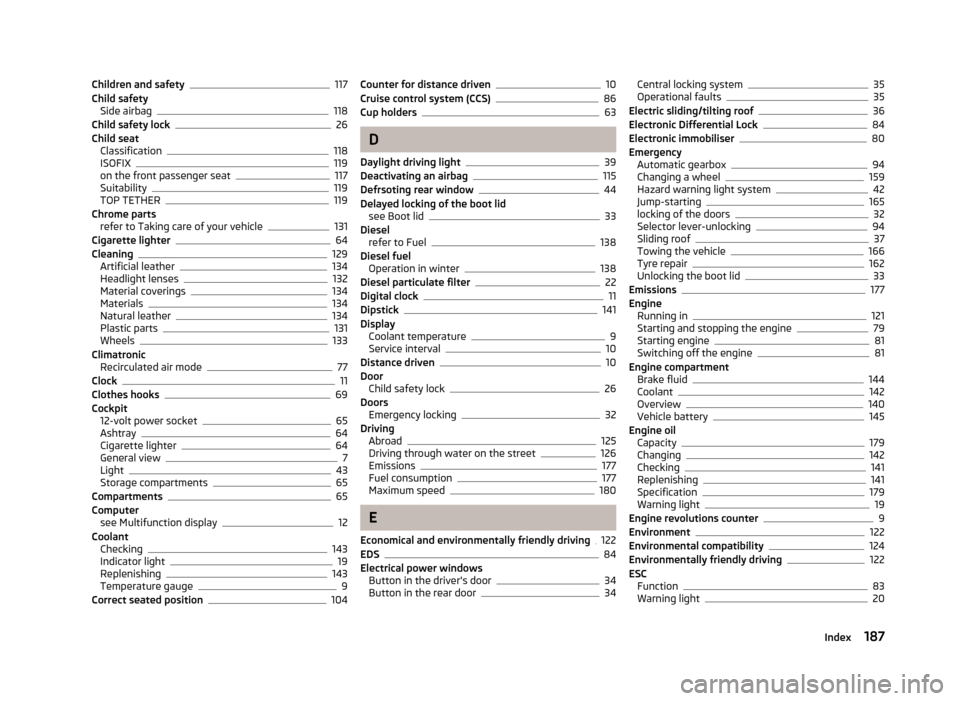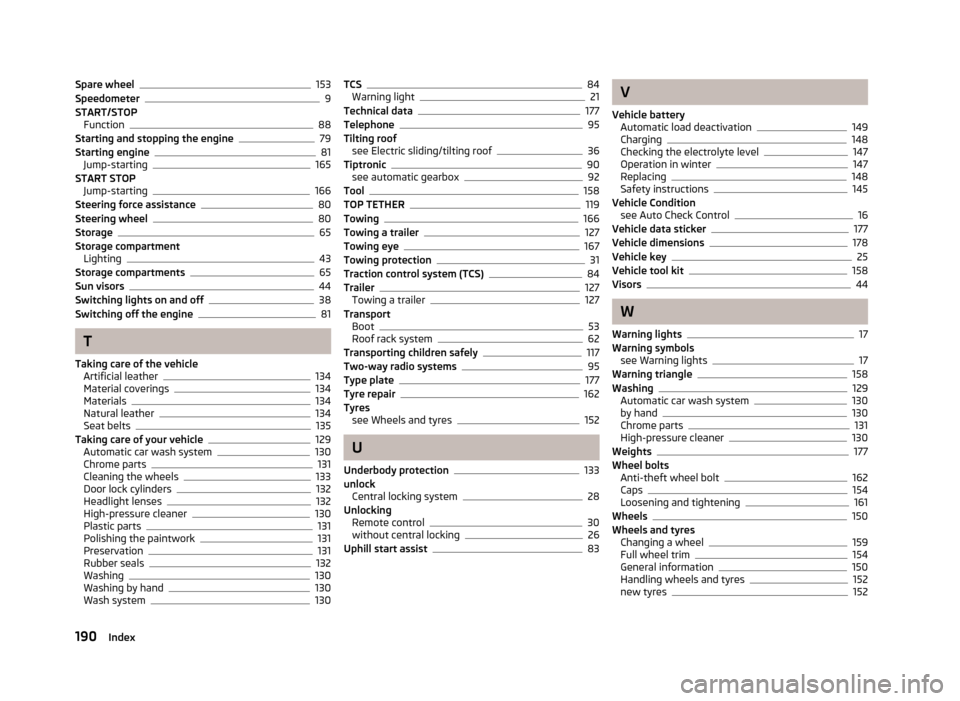check engine light SKODA FABIA 2012 2.G / 5J Owner's Guide
[x] Cancel search | Manufacturer: SKODA, Model Year: 2012, Model line: FABIA, Model: SKODA FABIA 2012 2.G / 5JPages: 196, PDF Size: 4.83 MB
Page 162 of 196

›
In the event of a puncture, park the vehicle as far away as possible from the
flow of traffic. The place you choose should be level.
› Let all of the occupants get out.
While changing a tyre, the occupants of the
vehicle should not stand on the road (instead they should remain behind a crash
barrier).
› Switch off the engine and move the gearshift lever into
Neutral or move the
selector lever for the automatic gearbox into position P .
› Firmly apply the
handbrake.
› If a trailer is connected, remove it.
› Remove the vehicle tool kit
» page 158 and the spare wheel » page 153, Spare
wheel from the boot. ÐChanging a wheel
First read and observe the introductory information and safety warn-
ings on page 159.
Always change a wheel on a level surface as far as possible.
›
Remove the full wheel trim
» page 154
or caps » page 154.
› In the case of light alloy wheel rims remove the wheel trim cap
» page 154.
› First of all slacken the anti-theft wheel bolt and then the other wheel
bolts » page 161.
› Jack up the vehicle until the wheel that needs changing is clear of the
ground » page 161.
› Unscrew the wheel bolts and place them on a clean surface (cloth, paper, etc.).
› Remove the wheel.
› Attach the spare wheel and slightly screw on the wheel bolts.
› Lower the vehicle.
› Alternately tighten the wheel bolts opposite each other using the wheel
wrench (crosswise) and then tighten the anti-theft wheel bolt » page 161.
› Reinstall the wheel trim/wheel trim cap or the caps. Note
■ All bolts must be clean and must turn easily.
■ Under no circumstances grease or oil the wheel bolts!
■ When fitting unidirectional tyres, ensure that the direction of rotation is cor-
rect »
page 153, Unidirectional tyres . Ð
ä Subsequent steps
First read and observe the introductory information and safety warn-
ings on page 159.
The following steps must also be performed after changing the wheel.
›
Stow and attach the replaced wheel in the spare wheel well using a special
screw » page 153, Spare wheel.
› Stow the vehicle tool kit in the space provided.
› Check
the tyre pressure
on the installed spare wheel as soon as possible.
› Have the
tightening torque of the wheel bolts checked with a torque wrench
as soon as possible.
› Change the damaged wheel or consult a ŠKODA specialist garage about repair
possibilities. Note
■ If it is determined that the wheel bolts are corroded and difficult to turn when
changing the wheel, the bolts must be replaced before checking the tightening
torque. ■ Drive cautiously and only at a moderate speed until the tightening torque has
been checked. Ð
ä
160 Do-it-yourself
Page 170 of 196

Fuses and light bulbs
Fuses
ä
Introduction
This chapter contains information on the following subjects:
Fuses in the dash panel 169
Fuses in the engine compartment 170
Individual electrical circuits are protected by fuses.
› Before replacing a fuse, switch off the ignition and the appropriate consumer
› Find out which fuse belongs to the component that is not operat-
ing » page 169, Fuses in the dash panel or » page 170, Fuses in the engine
compartment .
› Take the plastic clip out of its fixture in the cover of the fuse box, place it on the
relevant fuse and pull it out.
› A blown fuses is recognisable by the molten metal strip. Replace the faulty fuse
with a new one of the
same amperage.
Colour coding of fuses Colour Maximum amperage
light brown 5
dark brown 7.5
red 10
blue 15
yellow 20
white 25
green 30WARNING
Always read and observe the warnings before completing any work in the en-
gine compartment » page 138, Engine compartment . CAUTION
■ Never “repair” fuses and also do not replace them with a fuse of a higher am-
perage - risk of fire! This may also cause damage at another part of the electrical
system.
■ Have the electrical system checked as quickly as possible by a ŠKODA specialist
garage if a newly inserted fuse blows again after a short time. Note
■ We recommend always carrying replacement fuses in the vehicle. A box of re-
placement fuses can be purchased from
ŠKODA Original Accessories.
■ Multiple fuses may exist for a single power consuming device.
■ Multiple power consuming devices can share a single fuse. Ð
168 Do-it-yourself
Page 173 of 196

No. Power consumer
6 Glow plugs, radiator fan7 Electrohydraulic power steering
8 ABS or TCS or ESC 9 Radiator fan
10 Automatic gearbox 11 ABS or TCS or ESC
12 Central control unit
13 Electrical auxiliary heating system Note
Fuses 1 - 7 are replaced by a specialist ŠKODA garage. ÐBulbs
ä
Introduction
This chapter contains information on the following subjects:
Headlights 172
Replacing a bulb for low beam and main beam (halogen headlights) 172
Replacing a bulb for low beam and main beam Halogen projector
headlights) 173
Replacing the bulb for the main beam (Halogen projector headlights) 173
Changing the bulb for the front turn signal light 173
Changing the light bulb for the front parking light 173
Fog lights and daytime running lights 174
Fog lights Fabia Scout, Fabia RS 174
Licence plate light 175
Tail lamp assembly 175
Some manual skills are required to change a bulb. For this reason, if uncertain, we
recommend that bulbs are replaced by a ŠKODA specialist garage or other expert
help is sought. ›
Switch off the ignition and all of the lights before replacing a bulb.
› Faulty bulbs must only be replaced with the same type of bulbs. The designa-
tion is located on the light socket or the glass bulb.
› A stowage compartment for replacement bulbs is located in a plastic box in the
spare wheel or underneath the floor covering in the boot. WARNING
■ Accidents can be caused if the road in front of the vehicle is not sufficiently
illuminated and the vehicle cannot or can only be seen with difficulty by other
road users.
■ Always read and observe the warnings before completing any work in the
engine compartment » page 138, Engine compartment .
■ Bulbs H7 and H4 are pressurised and may burst when changing the bulb -
risk of injury! We therefore recommended wearing gloves and safety glasses
when changing a bulb. CAUTION
■ Do not take hold of the glass bulb with naked fingers (even the smallest
amount of dirt reduces the working life of the light bulb). Use a clean cloth, nap-
kin, or similar. ■ When removing and installing the tail light make sure that the paintwork of the
vehicle and the tail light are not damaged. Note
■ This Owner's Manual only describes the replacement of bulbs where it is possi-
ble to replace the bulbs on your own without any complications arising. Other
light bulbs should be changed by a
ŠKODA specialist garage.
■ We recommend that a box of replacement bulbs be always carried in the vehi-
cle. Replacement bulbs can be purchased from
ŠKODAOriginal Accessories.
■ We recommend that the headlight settings are checked by a ŠKODA specialist
garage after replacing a bulb in the main or low beam.
■ LED diodes should be changed by a specialist ŠKODA garage. Ð
171
Fuses and light bulbs
Page 188 of 196

Index
A
ABS 84
Warning light 21
Accessories 157
Adjusting Exterior mirror 48
Adjusting seats 104
Adjustment Seats 50
Aerial 130
see Radio reception 132
Airbag 111
Deployment 111
Front airbag 112
Head airbag 114
Side airbag 113
Airbag system 111
Air conditioning system Air outlet vents 71
Climatronic 76
Manual air conditioning system 73
Alarm 31
Anti-theft alarm system 31
Antilock brake system 84
Armrest 68
Ashtray 64
Assistance systems ESC 83
Assist systems ABS 21, 84
Cruise control systems (CCS) 86
EDS and XDS 84
ESC 20
Parking aid 85
START/STOP 88
TCS 21, 84Auto Check Control 16
Automatic gearbox 90
Dynamic shift programme 93
Emergency programme 94
Information for driving 90
Kickdown 93
Manual shifting of gears on the multifunction steering wheel 92
Parking 91
Selector lever-emergency unlocking 94
Selector lever lock 93
Selector lever positions 91
Starting off 91
Stopping 91
Tiptronic 92
Automatic load deactivation 149
AUX-IN 102
Avoiding damage to your vehicle 125
B
Before setting off 103
Belts 107
Belt tensioners 110
Bicycle carrier 60
Bonnet Closing 140
Opening 140
Boot Class
N1 vehicles 54
Cover 55
Emergency unlocking 33
Fastening elements 54
Fixing nets 55
foldable boot cover (Combi) 56
Folding hooks 54
Light 44
see Boot lid 33
Unlocking the boot lid 33
Boot lid 33
Automatic locking 33Brake assist 83
Brake booster 83
Brake fluid Checking 144
Brakes Brake booster 83
Handbrake 83
Running in 121
Warning light 18
Braking Brake fluid 144
Breakdown kit 162
Bulbs Replacing 171
Button in the driver's door Electrical power windows 34
C
Car computer see Multifunction display 12
Car jack 158
Carrier 62
Catalytic converter 121
Central locking button 29
Central locking system 27
lock 28
unlock 28
Changes 157
Changing Engine oil 142
Wheel 159
Charging a vehicle battery 148
Checking Battery electrolyte level 147
Brake fluid 144
Coolant level 143
Engine oil 141
Oil level 141
Windscreen washer fluid 145
186 Index
Page 189 of 196

Children and safety 117
Child safety Side airbag 118
Child safety lock 26
Child seat Classification 118
ISOFIX 119
on the front passenger seat 117
Suitability 119
TOP TETHER 119
Chrome parts refer to Taking care of your vehicle 131
Cigarette lighter 64
Cleaning 129
Artificial leather 134
Headlight lenses 132
Material coverings 134
Materials 134
Natural leather 134
Plastic parts 131
Wheels 133
Climatronic Recirculated air mode 77
Clock 11
Clothes hooks 69
Cockpit 12-volt power socket 65
Ashtray 64
Cigarette lighter 64
General view 7
Light 43
Storage compartments 65
Compartments 65
Computer see Multifunction display 12
Coolant Checking 143
Indicator light 19
Replenishing 143
Temperature gauge 9
Correct seated position 104Counter for distance driven 10
Cruise control system (CCS) 86
Cup holders 63
D
Daylight driving light 39
Deactivating an airbag 115
Defrsoting rear window 44
Delayed locking of the boot lid see Boot lid 33
Diesel refer to Fuel 138
Diesel fuel Operation in winter 138
Diesel particulate filter 22
Digital clock 11
Dipstick 141
Display Coolant temperature 9
Service interval 10
Distance driven 10
Door Child safety lock 26
Doors Emergency locking 32
Driving Abroad 125
Driving through water on the street 126
Emissions 177
Fuel consumption 177
Maximum speed 180
E
Economical and environmentally friendly driving 122
EDS 84
Electrical power windows Button in the driver's door 34
Button in the rear door 34Central locking system 35
Operational faults 35
Electric sliding/tilting roof 36
Electronic Differential Lock 84
Electronic immobiliser 80
Emergency Automatic gearbox 94
Changing a wheel 159
Hazard warning light system 42
Jump-starting 165
locking of the doors 32
Selector lever-unlocking 94
Sliding roof 37
Towing the vehicle 166
Tyre repair 162
Unlocking the boot lid 33
Emissions 177
Engine Running in 121
Starting and stopping the engine 79
Starting engine 81
Switching off the engine 81
Engine compartment Brake fluid 144
Coolant 142
Overview 140
Vehicle battery 145
Engine oil Capacity 179
Changing 142
Checking 141
Replenishing 141
Specification 179
Warning light 19
Engine revolutions counter 9
Environment 122
Environmental compatibility 124
Environmentally friendly driving 122
ESC Function 83
Warning light 20
187
Index
Page 192 of 196

Spare wheel 153
Speedometer 9
START/STOP Function 88
Starting and stopping the engine 79
Starting engine 81
Jump-starting 165
START STOP Jump-starting 166
Steering force assistance 80
Steering wheel 80
Storage 65
Storage compartment Lighting 43
Storage compartments 65
Sun visors 44
Switching lights on and off 38
Switching off the engine 81
T
Taking care of the vehicle Artificial leather 134
Material coverings 134
Materials 134
Natural leather 134
Seat belts 135
Taking care of your vehicle 129
Automatic car wash system 130
Chrome parts 131
Cleaning the wheels 133
Door lock cylinders 132
Headlight lenses 132
High-pressure cleaner 130
Plastic parts 131
Polishing the paintwork 131
Preservation 131
Rubber seals 132
Washing 130
Washing by hand 130
Wash system 130TCS 84
Warning light 21
Technical data 177
Telephone 95
Tilting roof see Electric sliding/tilting roof 36
Tiptronic 90
see automatic gearbox 92
Tool 158
TOP TETHER 119
Towing 166
Towing a trailer 127
Towing eye 167
Towing protection 31
Traction control system (TCS) 84
Trailer 127
Towing a trailer 127
Transport Boot 53
Roof rack system 62
Transporting children safely 117
Two-way radio systems 95
Type plate 177
Tyre repair 162
Tyres see Wheels and tyres 152
U
Underbody protection 133
unlock Central locking system 28
Unlocking Remote control 30
without central locking 26
Uphill start assist 83 V
Vehicle battery Automatic load deactivation 149
Charging 148
Checking the electrolyte level 147
Operation in winter 147
Replacing 148
Safety instructions 145
Vehicle Condition see Auto Check Control 16
Vehicle data sticker 177
Vehicle dimensions 178
Vehicle key 25
Vehicle tool kit 158
Visors 44
W
Warning lights 17
Warning symbols see Warning lights 17
Warning triangle 158
Washing 129
Automatic car wash system 130
by hand 130
Chrome parts 131
High-pressure cleaner 130
Weights 177
Wheel bolts Anti-theft wheel bolt 162
Caps 154
Loosening and tightening 161
Wheels 150
Wheels and tyres Changing a wheel 159
Full wheel trim 154
General information 150
Handling wheels and tyres 152
new tyres 152
190 Index